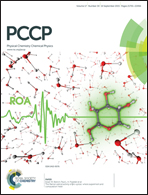Graphenol defects induced blue emission enhancement in chemically reduced graphene quantum dots†
Abstract
In this work, few layer graphene quantum dots (GQDs) with a size of 3–5 nm are purposely treated with highly concentrated aqueous NaBH4 solutions to obtain the reduced graphene quantum dots (rGQDs). Fourier transform infrared spectroscopy (FT-IR), X-ray photoelectron spectroscopy (XPS) and Raman spectroscopy demonstrate that the number of carbonyl groups decreases but –OH related defects increase during chemical reduction. Green and weak emissions of original GQDs originate from carrier recombination in the disorder-induced localized state (mainly including carbonyl and carboxyl and epoxy groups). As the reduction degree increases, the photoluminescence (PL) quantum efficiency of GQDs increases dramatically from 2.6% to 10.1%. In the meantime, the PL peak position blue shifts rapidly, and full width at half maximum (FWHM) becomes narrower. Thus we can infer that graphenol topological defects (hydroxyl functionalized graphene) are gradually formed during reduction. Besides, graphenol defect related PL features a longer fluorescence lifetime, excitation wavelength dependence but less pH sensitivity.


 Please wait while we load your content...
Please wait while we load your content...